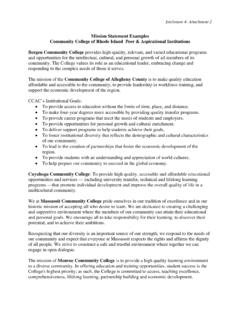Transcription of The Impact of Culture on a Child’s Learning - RIOPC
1 The Impact of Culture on a Child s LearningDavid J. SousaGear Up Grant Course CURR 508 Cultural CompetencyMustafa Ozcan, can teachers promote cultural infusion in the classroom?Culturally ResponsiveEducationCulturally Responsive Education Recognizes and Addresses :1. Student's Learning styles2. The different modes of reflective learning3. The role of group collaboration4. The function of non-verbal behaviorAn individual slearning style is theway he or she usesstrategies to help learn tasksand organizesinformation Some students are visual learners Meaning there is an emphasis on visual strategies and mental representations for processing information Others learn most effectively within small groups that focus on hands-on Learning Cooperative Learning activities opposed to individual.
2 Competitive activities are compatible with a number of Native American groups for exampleWith respect to Learning styles, be aware:Their silence may be interpreted as noncompliant, non-attentive or because a child does not respond to a question, does not mean they do not know the of a child s actions can put a child at risk for an inappropriate referral to special and Apache childrenfor example are not likely torespond to a question if itappears they are trying tocompete with their peersHow does this translate into the classroom Traditional teaching methods are culturally insensitive.
3 What is taught in typical teacher preparation courses is not the best approach. These practices can jeopardize or hinder a student s Learning . They may cause feelings of rejection, isolation and anxiety. These things can also cause teachers to feel frustrated and unable to reach their can be done to promote cultural infusion in the classroom?1. Teachers should be aware of the Learning characteristics of the students they serve to enhance their educational should learn to embrace students cultural Teachers should become flexibleto alter teaching practices in theirclassrooms4.
4 A teaching approach that develops group oriented classrooms and avoids focus on individual students can be much more successfulThese strategies can enrich education and alleviate fears that relate to loss of group identity, alienation, and anxiety during the Learning processExamples from:Teachers' Cultural Knowledge and Understanding of American Indian Studentsand Their Families: Impact of Culture on a Child's LearningPracticesProblemsSolutionsTeache rs tend toread a story insmall provide someinformation andthen checkstudents ComprehensionWith discussions.
5 And Indianchildren aretaught to hearall of theinformation andthen come to canaccommodate thestudents by exposingthem to the entirestory or largersegments of thestory to allowstudents to reflectand understand thewhole story and quiz children on new skills they are Learning so to assess a child'slevel aretaught to learnthrough modelingand areuncomfortablein demonstratingtheir skill leveluntil they havereached need toallow students timeto privatelypractice learningthe new canrequest volunteersto should beprivate and not bea public teachersask questions ofchildren in theclassroom, theyexpect a verbalresponse fromThe childrenare taught to beComfortablewith a child doesnot verballyrespond to ateacher, the childmay be consideredrude notpublicly addressstudents whoare quietlearners.
6 If astudent is doingfine in class andchooses not toanswer, allowthis often havecompetitionswithin schoolactivities orassignments tosee who the firstto get done is orwho can do thetask the studentsare taught towork in unityand to helpothers for thebenefit of thegroup not solelyto benefit his shouldemphasizeCooperativeworkassignment s asopposed tocompetitiveactivitieswithin will the future hold? Training agencies, in-service delivery, and other teacher preparation programs should focus on using the solutions to the problems discussed in this article Without this type of attention, we will continue to see high drop out rates, low graduation rates from high school, and a disproportionate over representation of students in special education programs.
7 This is a critical issue for rural schools. Rural families have maintained their traditional values and continue to pass these values on. Their cultural beliefs and values are subtly engrained through teachings and experiences within their family and community systems. If our education system is culturally unresponsive to these values, the educational Impact may be devastating. Be aware of your students Learning styles Embrace other cultures Be willing to changeEVERYONE SUCEEDS!!Teachers' Cultural Knowledge and Understandingof American Indian Students and Their Families: Impact of Culture on a Child's LearningLawrence Ingalls, Helen HammondUniversity of Texas @ El PasoErrol DupouxSt.
8 Petersburg College/Gibb CampusRosalinda BaezaMescalero Apache High SchoolMescalaro, New MexicoInformation obtained from.




